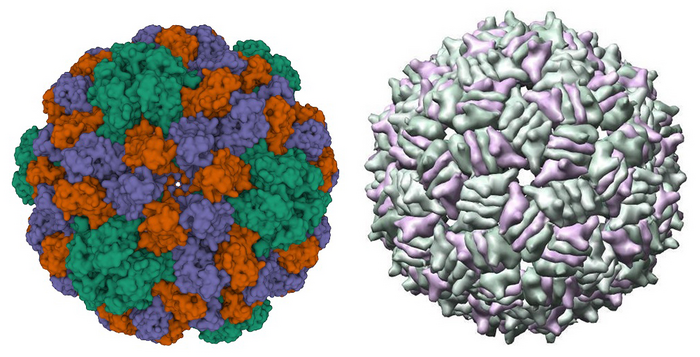How do the hundreds of individual pieces that make up viruses assemble into shapes capable of spreading disease from cell to cell?

Credit: Brome mosaic virus capsid: Lucas, R.W., Larson, S.B., McPherson, A., (2002) J Mol Biol 317: 95-108 – https://www.rcsb.org/structure/1JS9; MS2 virus capsid: Rowsell, S., Stonehouse, N.J., Convery, M.A., Adams, C.J., Ellington, A.D., Hirao, I., Peabody, D.S., Stockley, P.G., Phillips, S.E., (1998) Nat Struct Biol 5: 970-975 – https://www.rcsb.org/structure/5MSF
How do the hundreds of individual pieces that make up viruses assemble into shapes capable of spreading disease from cell to cell?
Solving the mystery of self-assembly can pave the way for engineering advancements like molecules or robots that put themselves together. It could also contribute to more efficient packaging, automated delivery and targeted design of medicine in our fight against viruses that cause colds, diarrhea, liver cancer and polio.
“If we understand the physical rules of how viruses assemble, then we can try to make them form incorrect structures to hinder their spread,” said Rees Garmann, a chemist at San Diego State University and lead author of a new paper that fills in a piece of the puzzle.
Garmann, along with two SDSU graduate students and collaborators at Harvard and UCLA, concluded that two distantly related RNA viruses — one that infects bacteria and one that infects plants — perform this chemical choreography in strikingly similar ways.
In both, and potentially other, viruses, the protein components perfectly pattern into pentagons and hexagons that form a symmetrical icosahedral shell, one of the most prevalent shapes among all viruses, thanks to a scaffold provided by a looped and folded strand of RNA.
Similar to how a snowflake requires a couple of molecules of frigid water to surround a dust particle before crystallizing, a virus’s jungle-gym-like sphere of proteins coalesces quickly only after a few proteins loosely attach to the RNA.
“Without the interactions between the proteins and the RNA that my students, Fernando Vasquez and Daniel Villareal, were studying, it would take a very long time — weeks, months, maybe never — for this virus to assemble,” Garmann said.
Yet the whole assembly process, which Garmann and his collaborators captured in detailed videos using an innovative iSCAT (interferometric scattering) microscope that records individual viruses, takes mere minutes.
“The iSCAT technique opened a new window onto virus self-assembly,” said Vinothan N. Manoharan, a co-author on the study and the Wagner Family Professor of Chemical Engineering and Professor of Physics at Harvard’s John A. Paulson School of Engineering and Applied Sciences. “Only by seeing individual viruses form could we determine that they don’t all assemble at the same time. That was key to understanding the self-assembly mechanism that the two types of virus share.”
Garmann says their experiments point the way to answering the next big mystery of how viruses ensure accuracy and functionality at all steps along the assembly line.
Knowing more about how viruses assemble is related to the 1950s-era physics paradox of how proteins fold into their proper shapes much faster than if they relied solely on chance encounters — a process estimated to take longer than the billions of years the universe has existed.
One Case Closed, Others Opened
Although the viruses in this study and the virus that causes COVID-19 both have RNA, the researchers say that extending these findings to the bigger, oddball SARS-CoV-2 virus would be premature.
“The hope of our research is to learn about some physical, fundamental interaction that occurs in these model systems,” said Vasquez, a doctoral student in chemistry. “Maybe with more data and time, they can be applied to studying a new virus.”
“Self-assembly — designing components that know how to get together — is totally different from how we build ordinary things,” Garmann said. “As engineers, we have a lot to learn from viruses.”
###
About San Diego State University
San Diego State University is a major public research institution that provides transformative experiences for its more than 36,000 students. SDSU offers bachelor’s degrees in 96 areas, master’s degrees in 84 fields and doctorates in 23 areas, with additional certificates and programs at regional microsites. SDSU ranks as the number 1 California State University in federal research support, as one of the top public research universities in California. In addition to academic offerings at SDSU, SDSU Imperial Valley and SDSU Georgia, SDSU Global Campus offers online training, certificates and degrees in areas of study designed to meet the needs of students everywhere. Students participate in transformational research, international experiences, sustainability and entrepreneurship initiatives, internships and mentoring, and a broad range of student life and leadership opportunities. SDSU is committed to inclusive excellence and is known for its efforts in advancing diversity and inclusion. SDSU is nationally recognized for its study abroad initiatives, veterans’ programs and support of LGBTQA+ students, as well as its powerhouse Division I Athletics Program. About 50% of SDSU’s undergraduate and graduate students are students of color. The university resides on Kumeyaay land and was most recently recognized as an Asian American Native American Pacific Islander-Serving Institution (AANAPISI). SDSU is also a long-standing Hispanic-Serving Institution (HSI). The university’s rich campus life and location offers opportunities for students to lead and engage with the creative and performing arts, career and internship opportunities with SDSU’s more than 491,000 living alumni, and the vibrant cultural life of the greater San Diego and U.S.- Mexico region.
Journal
Proceedings of the National Academy of Sciences
DOI
10.1073/pnas.2206292119
Method of Research
Experimental study
Subject of Research
Cells
Article Title
Single-particle studies of the effects of RNA–protein interactions on the self-assembly of RNA virus particles
Article Publication Date
19-Sep-2022
COI Statement
The authors declare no competing financial interests.




